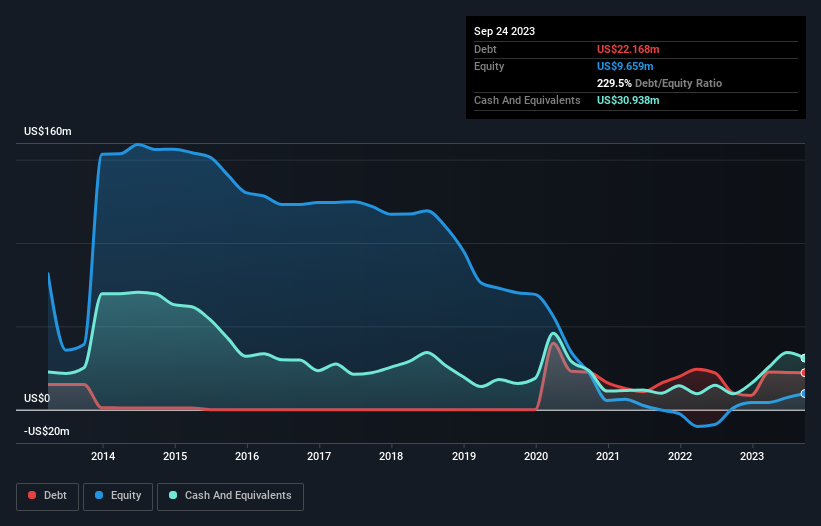- United States
- /
- Hospitality
- /
- NasdaqGS:PBPB
Here's Why Potbelly (NASDAQ:PBPB) Can Manage Its Debt Responsibly
David Iben put it well when he said, 'Volatility is not a risk we care about. What we care about is avoiding the permanent loss of capital.' So it might be obvious that you need to consider debt, when you think about how risky any given stock is, because too much debt can sink a company. We can see that Potbelly Corporation (NASDAQ:PBPB) does use debt in its business. But should shareholders be worried about its use of debt?
When Is Debt Dangerous?
Generally speaking, debt only becomes a real problem when a company can't easily pay it off, either by raising capital or with its own cash flow. If things get really bad, the lenders can take control of the business. However, a more frequent (but still costly) occurrence is where a company must issue shares at bargain-basement prices, permanently diluting shareholders, just to shore up its balance sheet. Of course, plenty of companies use debt to fund growth, without any negative consequences. The first thing to do when considering how much debt a business uses is to look at its cash and debt together.
See our latest analysis for Potbelly
How Much Debt Does Potbelly Carry?
As you can see below, at the end of September 2023, Potbelly had US$22.2m of debt, up from US$10.1m a year ago. Click the image for more detail. But on the other hand it also has US$30.9m in cash, leading to a US$8.77m net cash position.

A Look At Potbelly's Liabilities
According to the last reported balance sheet, Potbelly had liabilities of US$69.9m due within 12 months, and liabilities of US$171.8m due beyond 12 months. Offsetting these obligations, it had cash of US$30.9m as well as receivables valued at US$7.90m due within 12 months. So it has liabilities totalling US$202.8m more than its cash and near-term receivables, combined.
While this might seem like a lot, it is not so bad since Potbelly has a market capitalization of US$410.4m, and so it could probably strengthen its balance sheet by raising capital if it needed to. But we definitely want to keep our eyes open to indications that its debt is bringing too much risk. While it does have liabilities worth noting, Potbelly also has more cash than debt, so we're pretty confident it can manage its debt safely.
We also note that Potbelly improved its EBIT from a last year's loss to a positive US$12m. The balance sheet is clearly the area to focus on when you are analysing debt. But it is future earnings, more than anything, that will determine Potbelly's ability to maintain a healthy balance sheet going forward. So if you want to see what the professionals think, you might find this free report on analyst profit forecasts to be interesting.
But our final consideration is also important, because a company cannot pay debt with paper profits; it needs cold hard cash. Potbelly may have net cash on the balance sheet, but it is still interesting to look at how well the business converts its earnings before interest and tax (EBIT) to free cash flow, because that will influence both its need for, and its capacity to manage debt. Over the last year, Potbelly recorded free cash flow worth a fulsome 85% of its EBIT, which is stronger than we'd usually expect. That puts it in a very strong position to pay down debt.
Summing Up
While Potbelly does have more liabilities than liquid assets, it also has net cash of US$8.77m. The cherry on top was that in converted 85% of that EBIT to free cash flow, bringing in US$10m. So we don't have any problem with Potbelly's use of debt. When analysing debt levels, the balance sheet is the obvious place to start. However, not all investment risk resides within the balance sheet - far from it. We've identified 2 warning signs with Potbelly , and understanding them should be part of your investment process.
At the end of the day, it's often better to focus on companies that are free from net debt. You can access our special list of such companies (all with a track record of profit growth). It's free.
New: Manage All Your Stock Portfolios in One Place
We've created the ultimate portfolio companion for stock investors, and it's free.
• Connect an unlimited number of Portfolios and see your total in one currency
• Be alerted to new Warning Signs or Risks via email or mobile
• Track the Fair Value of your stocks
Have feedback on this article? Concerned about the content? Get in touch with us directly. Alternatively, email editorial-team (at) simplywallst.com.
This article by Simply Wall St is general in nature. We provide commentary based on historical data and analyst forecasts only using an unbiased methodology and our articles are not intended to be financial advice. It does not constitute a recommendation to buy or sell any stock, and does not take account of your objectives, or your financial situation. We aim to bring you long-term focused analysis driven by fundamental data. Note that our analysis may not factor in the latest price-sensitive company announcements or qualitative material. Simply Wall St has no position in any stocks mentioned.
About NasdaqGS:PBPB
Potbelly
Owns, operates, and franchises Potbelly sandwich shops in the United States.
Adequate balance sheet with moderate growth potential.
Similar Companies
Market Insights
Community Narratives



